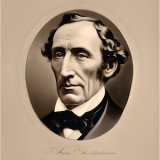The Old Church Bell Page #2
"The Old Church Bell" is a short, poignant story by Hans Christian Andersen about the life journeys of a church bell. It recounts its creation, installation, ringing at significant events, and finally being replaced and forgotten as time passes. The book elicits empathy for the inanimate object, demonstrating Andersen's incredible storytelling ability to blend humanity with elements of the unseen world.
it stood in the shelter of the church wall in Marbach, once so elevated, now quite forgotten. The wind roared around it, and could have readily related the story of its origin and of its sweet chimes, and the wind could also tell of him to whom he had brought fresh air when, in the woods of a neighboring country, he had sunk down exhausted with fatigue, with no other worldly possessions than hope for the future, and a written leaf from "Fiesco." The wind could have told that his only protector was an artist, who, by reading each leaf to him, made it plain; and that they amused themselves by playing at nine-pins together. The wind could also describe the pale fugitive, who, for weeks and months, lay in a wretched little road-side inn, where the landlord got drunk and raved, and where the merry-makers had it all their own way. And he, the pale fugitive, sang of the ideal. For many heavy days and dark nights the heart must suffer to enable it to endure trial and temptation; yet, amidst it all, would the minstrel sing. Dark days and cold nights also passed over the old bell, and it noticed them not; but the bell in the man's heart felt it to be a gloomy time. What would become of this young man, and what would become of the old bell? The old bell was, after a time, carried away to a greater distance than any one, even the warder in the bell tower, ever imagined; and the bell in the breast of the young man was heard in countries where his feet had never wandered. The tones went forth over the wide ocean to every part of the round world. We will now follow the career of the old bell. It was, as we have said, carried far away from Marbach and sold as old copper; then sent to Bavaria to be melted down in a furnace. And then what happened? In the royal city of Bavaria, many years after the bell had been removed from the tower and melted down, some metal was required for a monument in honor of one of the most celebrated characters which a German people or a German land could produce. And now we see how wonderfully things are ordered. Strange things sometimes happen in this world. In Denmark, in one of those green islands where the foliage of the beech-woods rustles in the wind, and where many Huns' graves may be seen, was another poor boy born. He wore wooden shoes, and when his father worked in a ship-yard, the boy, wrapped up in an old worn-out shawl, carried his dinner to him every day. This poor child was now the pride of his country; for the sculptured marble, the work of his hands, had astonished the world.[1] To him was offered the honor of forming from the clay, a model of the figure of him whose name, "John Christopher Frederick," had been written by his father in the Bible. The bust was cast in bronze, and part of the metal used for this purpose was the old church bell, whose tones had died away from the memory of those at home and elsewhere. The metal, glowing with heat, flowed into the mould, and formed the head and bust of the statue which was unveiled in the square in front of the old castle. The statue represented in living, breathing reality, the form of him who was born in poverty, the boy from Marbach, the pupil of the military school, the fugitive who struggled against poverty and oppression, from the outer world; Germany's great and immortal poet, who sung of Switzerland's deliverer, William Tell, and of the heaven-inspired Maid of Orleans. It was a beautiful sunny day; flags were waving from tower and roof in royal Stuttgart, and the church bells were ringing a joyous peal. One bell was silent; but it was illuminated by the bright sunshine which streamed from the head and bust of the renowned figure, of which it formed a part. On this day, just one hundred years had passed since the day on which the chiming of the old church bell at Marbach had filled the mother's heart with trust and joy--the day on which her child was born in poverty, and in a humble home; the same who, in after-years, became rich, became the noble woman-hearted poet, a blessing to the world--the glorious, the sublime, the immortal bard, John Christoper Frederick Schiller! [1] The Danish sculptor Thorwaldsen.
Translation
Translate and read this book in other languages:
Select another language:
- - Select -
- 简体中文 (Chinese - Simplified)
- 繁體中文 (Chinese - Traditional)
- Español (Spanish)
- Esperanto (Esperanto)
- 日本語 (Japanese)
- Português (Portuguese)
- Deutsch (German)
- العربية (Arabic)
- Français (French)
- Русский (Russian)
- ಕನ್ನಡ (Kannada)
- 한국어 (Korean)
- עברית (Hebrew)
- Gaeilge (Irish)
- Українська (Ukrainian)
- اردو (Urdu)
- Magyar (Hungarian)
- मानक हिन्दी (Hindi)
- Indonesia (Indonesian)
- Italiano (Italian)
- தமிழ் (Tamil)
- Türkçe (Turkish)
- తెలుగు (Telugu)
- ภาษาไทย (Thai)
- Tiếng Việt (Vietnamese)
- Čeština (Czech)
- Polski (Polish)
- Bahasa Indonesia (Indonesian)
- Românește (Romanian)
- Nederlands (Dutch)
- Ελληνικά (Greek)
- Latinum (Latin)
- Svenska (Swedish)
- Dansk (Danish)
- Suomi (Finnish)
- فارسی (Persian)
- ייִדיש (Yiddish)
- հայերեն (Armenian)
- Norsk (Norwegian)
- English (English)
Citation
Use the citation below to add this book to your bibliography:
Style:MLAChicagoAPA
"The Old Church Bell Books." Literature.com. STANDS4 LLC, 2025. Web. 22 Jan. 2025. <https://www.literature.com/book/the_old_church_bell_2203>.




Discuss this The Old Church Bell book with the community:
Report Comment
We're doing our best to make sure our content is useful, accurate and safe.
If by any chance you spot an inappropriate comment while navigating through our website please use this form to let us know, and we'll take care of it shortly.
Attachment
You need to be logged in to favorite.
Log In